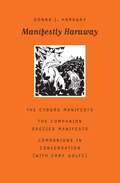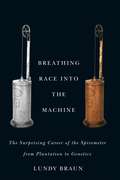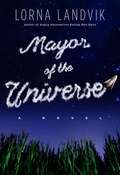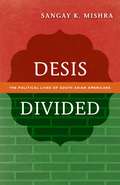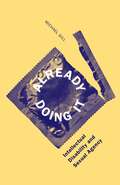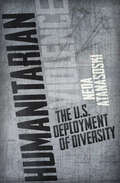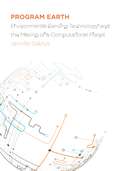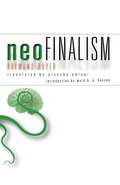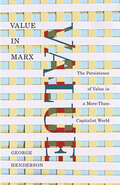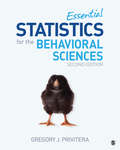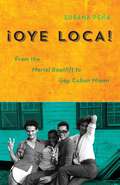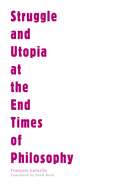- Table View
- List View
Manifestly Haraway (Posthumanities #37)
by Donna J. HarawayElectrifying, provocative, and controversial when first published thirty years ago, Donna Haraway&’s &“Cyborg Manifesto&” is even more relevant today, when the divisions that she so eloquently challenges—of human and machine but also of gender, class, race, ethnicity, sexuality, and location—are increasingly complex. The subsequent &“Companion Species Manifesto,&” which further questions the human–nonhuman disjunction, is no less urgently needed in our time of environmental crisis and profound polarization.Manifestly Haraway brings together these momentous manifestos to expose the continuity and ramifying force of Haraway&’s thought, whose significance emerges with engaging immediacy in a sustained conversation between the author and her long-term friend and colleague Cary Wolfe. Reading cyborgs and companion species through and with each other, Haraway and Wolfe join in a wide-ranging exchange on the history and meaning of the manifestos in the context of biopolitics, feminism, Marxism, human–nonhuman relationships, making kin, literary tropes, material semiotics, the negative way of knowing, secular Catholicism, and more.The conversation ends by revealing the early stages of Haraway&’s &“Chthulucene Manifesto,&” in tension with the teleologies of the doleful Anthropocene and the exterminationist Capitalocene. Deeply dedicated to a diverse and robust earthly flourishing, Manifestly Haraway promises to reignite needed discussion in and out of the academy about biologies, technologies, histories, and still possible futures.
Breathing Race into the Machine: The Surprising Career of the Spirometer from Plantation to Genetics
by Lundy BraunHow race became embedded in a medical instrument In the antebellum South, plantation physicians used a new medical device—the spirometer—to show that lung volume and therefore vital capacity were supposedly less in black slaves than in white citizens. At the end of the Civil War, a large study of racial difference employing the spirometer appeared to confirm the finding, which was then applied to argue that slaves were unfit for freedom. What is astonishing is that this example of racial thinking is anything but a historical relic.In Breathing Race into the Machine, science studies scholar Lundy Braun traces the little-known history of the spirometer to reveal the social and scientific processes by which medical instruments have worked to naturalize racial and ethnic differences, from Victorian Britain to today. Routinely a factor in clinical diagnoses, preemployment physicals, and disability estimates, spirometers are often &“race corrected,&” typically reducing normal values for African Americans by 15 percent.An unsettling account of the pernicious effects of racial thinking that divides people along genetic lines, Breathing Race into the Machine helps us understand how race enters into science and shapes medical research and practice. Honorable Mention, 2017 Rachel Carson Prize, Society for the Social Studies of Science Winner of the 2018 Ludwik Fleck Prize from the Society for Social Studies of Science
Wolf Shadows: Wolf Shadows (A Fesler-Lampert Minnesota Heritage Book)
by Mary CasanovaIn this sequel to Mary Casanova&’s exciting Moose Tracks, twelve-year-old Seth is back for a new adventure. A debate is brewing in his northern Minnesota town over the growing wolf packs and the programs that are in place for their protection. Although he fears them, Seth can&’t help but want to see the wolves thrive.Seth&’s feelings put him at odds with those who want to hunt wolves again—including his best friend Matt, whose family believes that the wolf population poses a serious threat to their livestock. Torn between his love of animals and his best friend, Seth is unsure of what to do. When Matt commits a horrible act of violence, Seth angrily abandons him in the woods, unaware that a blizzard is on the way. Now Seth must try to rescue his friend—but will he be able to save their friendship?
Political Matter: Technoscience, Democracy, and Public Life
by Jane Bennett Isabelle StengersTaking seriously the argument that things have politics, Political Matter seeks to develop a fully materialist theory of politics, one that opens new possibilities for imagining the relationship between scientific and political practices. The contributors assert that without such a theory the profusion of complex materials with and through which we live-plastic bags, smart cars, and long-life lightbulbs, for example-too often leaves us oscillating between fearful repudiation and glib celebration.Exploring the frictions that come from linking the work of scholars in science and technology studies and political theory, these essays spark new ways of understanding the matter of politics.Contributors: Andrew Barry, U of Oxford; Jane Bennett, Johns Hopkins U; Stephen J. Collier, New School; William E. Connolly, Johns Hopkins U; Rosalyn Diprose, U of New South Wales; Lisa Disch, U of Michigan; Gay Hawkins, U of New South Wales; Andrew Lakoff, UC San Diego; Noortje Marres, U of London; Isabelle Stengers, U Libre de Bruxelles; Nigel Thrift, U of Warwick.
Mayor of the Universe: A Novel
by Lorna LandvikA mild-mannered actuary, Fletcher Weschel lives at the crossroads of Bland and Humdrum—or so he thinks until a cosmic contest catapults him into the fantasy world he made up as a boy. Suddenly his childhood bedroom is aswarm with aliens, all bent on discovering the human who best personifies their mission—in this case, the deeply serious pursuit of fun. Ejected from the boring comfort of his office chair, Fletcher finds himself astride the bare back of a horse, in front of a safe (that he happens to be cracking), and then . . . in the cabin of a weight-loss camp for kids? Apparently adventures come in all shapes and sizes, and it&’s up to Fletcher to make the most of these, conducted by his alien guide, Tandala, who takes on the corporeal form of a big-boned Jamaican and tends to get distracted by Earth&’s many surprising pleasures (garlic! libraries! love!).But even fantasies can have consequences, and as Fletcher struggles through them, he is cheered and assisted by Wanda Plum, a plucky second-grade teacher who helps him realize what his ultimate role really is on this highly mysterious, infinitely marvelous pale-blue dot in a vast universe. Though its cast includes aliens, this charmed and charming book is quintessential Lorna Landvik—less about outer space than about the crowded, complex inner space of the human heart.
Desis Divided: The Political Lives of South Asian Americans
by Sangay K. MishraFor immigrants to America, from Europeans in the early twentieth century through later Latinos, Asians, and Caribbeans, gaining social and political ground has generally been considered an exercise in ethnic and racial solidarity. The experience of South Asian Americans, one of the fastest-growing immigrant populations in recent years, tells a different story of inclusion—one in which distinctions within a group play a significant role.Focusing on Indian, Pakistani, and Bangladeshi American communities, Sangay K. Mishra analyzes features such as class, religion, nation of origin, language, caste, gender, and sexuality in mobilization. He shows how these internal characteristics lead to multiple paths of political inclusion, defying a unified group experience. How, for instance, has religion shaped the fractured political response to intensified discrimination against South Asians—Hindus, Muslims, and Sikhs—in the post-9/11 period? How have class and home country concerns played into various strategies for achieving political power? And how do the political engagements of professional and entrepreneurial segments of the community challenge the idea of a unified diaspora? Pursuing answers, Mishra argues that, while ethnoracial mobilization remains an important component of South Asian American experience, ethnoracial identity is deployed differently by particular sectors of the South Asian population to produce very specific kinds of mobilizing and organizational infrastructures. And exploring these distinctions is critical to understanding the changing nature of the politics of immigrant inclusion—and difference itself—in America.
Brown Threat: Identification in the Security State
by Kumarini SilvaWhat is &“brown&” in—and beyond—the context of American identity politics? How has the concept changed since 9/11? In the most sustained examination of these questions to date, Kumarini Silva argues that &“brown&” is no longer conceived of solely as a cultural, ethnic, or political identity. Instead, after 9/11, the Patriot Act, and the wars in Iran, Iraq, and Afghanistan, it has also become a concept and, indeed, a strategy of identification—one rooted in xenophobic, imperialistic, and racist ideologies to target those who do not neatly fit or subscribe to ideas of nationhood. Interweaving personal narratives, ethnographic research, analyses of popular events like the Miss America pageant, and films and TV shows such as the Harold and Kumar franchise and Black-ish, Silva maps junctures where the ideological, political, and mediated terrain intersect, resulting in an appetite for all things &“brown&” (especially South Asian brown) by U.S. consumers, while political and nationalist discourses and legal structures (immigration, emigration, migration, outsourcing, incarceration) conspire to control brown bodies both within and outside the United States. Silva explores this contradictory relationship between representation and reality, arguing that the representation mediates and manages the anxieties that come from contemporary global realities, in which brown spaces, like India, Pakistan, and the Middle East pose key economic, security, and political challenges to the United States. While racism is hardly new, what makes this iteration of brown new is that anyone or any group, at any time, can be branded as deviant, as a threat.
Robot Ghosts and Wired Dreams: Japanese Science Fiction from Origins to Anime
by Takayuki Tatsumi Christopher Bolton Istvan Csicsery-Ronay JR.Since the end of the Second World War—and particularly over the last decade—Japanese science fiction has strongly influenced global popular culture. Unlike American and British science fiction, its most popular examples have been visual—from Gojira (Godzilla) and Astro Boy in the 1950s and 1960s to the anime masterpieces Akira and Ghost in the Shell of the 1980s and 1990s—while little attention has been paid to a vibrant tradition of prose science fiction in Japan. Robot Ghosts and Wired Dreams remedies this neglect with a rich exploration of the genre that connects prose science fiction to contemporary anime. Bringing together Western scholars and leading Japanese critics, this groundbreaking work traces the beginnings, evolution, and future direction of science fiction in Japan, its major schools and authors, cultural origins and relationship to its Western counterparts, the role of the genre in the formation of Japan&’s national and political identity, and its unique fan culture. Covering a remarkable range of texts—from the 1930s fantastic detective fiction of Yumeno Kyûsaku to the cross-culturally produced and marketed film and video game franchise Final Fantasy—this book firmly establishes Japanese science fiction as a vital and exciting genre. Contributors: Hiroki Azuma; Hiroko Chiba, DePauw U; Naoki Chiba; William O. Gardner, Swarthmore College; Mari Kotani; Livia Monnet, U of Montreal; Miri Nakamura, Stanford U; Susan Napier, Tufts U; Sharalyn Orbaugh, U of British Columbia; Tamaki Saitô; Thomas Schnellbächer, Berlin Free U. Christopher Bolton is assistant professor of Japanese at Williams College. Istvan Csicsery-Ronay Jr. is professor of English at DePauw University. Takayuki Tatsumi is professor of English at Keio University.
Already Doing It: Intellectual Disability and Sexual Agency
by Michael GillWhy is the sexuality of people with intellectual disabilities often deemed &“risky&” or &“inappropriate&” by teachers, parents, support staff, medical professionals, judges, and the media? Should sexual citizenship depend on IQ? Confronting such questions head-on, Already Doing It exposes the &“sexual ableism&” that denies the reality of individuals who, despite the restrictions they face, actively make decisions about their sexual lives.Tracing the history of efforts in the United States to limit the sexual freedoms of such persons⎯using methods such as forced sterilization, invasive birth control, and gender-segregated living arrangements—Michael Gill demonstrates that these widespread practices stemmed from dominant views of disabled sexuality, not least the notion that intellectually disabled women are excessively sexual and fertile while their male counterparts are sexually predatory. Analyzing legal discourses, sex education materials, and news stories going back to the 1970s, he shows, for example, that the intense focus on &“stranger danger&” in sex education for intellectually disabled individuals disregards their ability to independently choose activities and sexual partners—including nonheterosexual ones, who are frequently treated with heightened suspicion. He also examines ethical issues surrounding masturbation training that aims to regulate individuals&’ sexual lives, challenges the perception that those whose sexuality is controlled (or rejected) should not reproduce, and proposes recognition of the right to become parents for adults with intellectual disabilities. A powerfully argued call for sexual and reproductive justice for people with intellectual disabilities, Already Doing It urges a shift away from the compulsion to manage &“deviance&” (better known today as harm reduction) because the right to pleasure and intellectual disability are not mutually exclusive. In so doing, it represents a vital new contribution to the ongoing debate over who, in the United States, should be allowed to have sex, reproduce, marry, and raise children.
Scenarios II: Signs of Life; Even Dwarfs Started Small; Fata Morgana; Heart of Glass
by Werner HerzogThe second in a series: the master filmmaker&’s prose scenarios for four of his notable filmsOn the first day of editing Fata Morgana, Werner Herzog recalls, his editor said: &“With this kind of material we have to pretend to invent cinema.&” And this, Herzog says, is what he tries to do every day. In this second volume of his scenarios, the peerless filmmaker&’s genius for invention is on clear display. Written in Herzog&’s signature fashion—more prose poem than screenplay, transcribing the vision unfolding before him as if in a dream—the four scenarios here (three never before translated into English) reveal an iconoclastic craftsman at the height of his powers.Along with his template for the film poem Fata Morgana (1971), this volume includes the scenarios for Herzog&’s first two feature films, Signs of Life (1968) and Even Dwarfs Started Small (1970), along with the hypnotic Heart of Glass (1976). In a brief introduction, Herzog describes the circumstances surrounding each scenario, inviting readers into the mysterious process whereby one man&’s vision becomes every viewer&’s waking dream.
The American Isherwood
by James J. Berg Freeman ChrisNovelist, memoirist, diarist, and gay pioneer Christopher Isherwood left a wealth of writings. Known for his crisp style and his camera-like precision with detail, Isherwood gained fame for his Berlin Stories, which served as source material for the hit stage musical and Academy Award–winning film Cabaret. More recently, his experiences and career in the United States have received increased attention. His novel A Single Man was adapted into an Oscar-nominated film; his long relationship with the artist Don Bachardy, with whom he shared an openly gay lifestyle, was the subject of an award-winning documentary, Chris & Don: A Love Story; and his memoir, Christopher and His Kind, was adapted for the BBC. Isherwood&’s colorful journeys took him from post–World War I England to Weimar Germany to European exile to Golden Age Hollywood to Los Angeles in the full flower of gay liberation. After the publication of his diaries, which run to more than one million words and span nearly a half century, it is possible to fully assess his influence. This collection of essays considers Isherwood&’s diaries, his vast personal archive, and his published works and offers a multifaceted appreciation of a writer who spent more than half of his life in southern California. James J. Berg and Chris Freeman have brought together the most informative scholarship of the twenty-first century to illuminate the craft of one of the singular figures of the twentieth century. Isherwood, the American, emerges from the shadow of his English reputation to stake his claim as a significant force in late twentieth-century American culture whose legacy continues in the twenty-first century.Contributors: Joshua Adair, Murray State U; Jamie Carr, Niagara U; Robert L. Caserio, Pennsylvania State U; Niladri Chatterjee, U of Kalyani, India; Lisa Colletta, American U of Rome; Lois Cucullu, U of Minnesota; Mario Faraone; Peter Edgerly Firchow; Rebecca Gordon Stewart; William R. Handley, U of Southern California; Jaime Harker, U of Mississippi; Sara S. Hodson, Huntington Library; Carola M. Kaplan, California State U, Pomona; Benjamin Kohlmann, U of Freiburg, Germany; Victor Marsh, U of Queensland; Tina Mascara; Stephen McCauley; Paul M. McNeil, Columbia U; Guido Santi, College of the Canyons, California; Kyle Stevens, Brandeis U.
The Marrying Kind?: Debating Same-Sex Marriage within the Lesbian and Gay Movement
by Mary Bernstein and Verta TaylorAs the fight for same-sex marriage rages across the United States and lesbian and gay couples rush to marriage license counters, the goal of marriage is still fiercely questioned within the LGBT movement. Rarely has an objective so central to a social movement&’s political agenda been so controversial within the movement itself. While antigay forces work to restrict marriage to one man and one woman, lesbian and gay activists are passionately arguing about the desirability, viability, and social consequences of same-sex marriage. The Marrying Kind? is the first book to draw on empirical research to examine these debates and how they are affecting marriage equality campaigns. The essays in this volume analyze the rhetoric, strategies, and makeup of the LGBT social movement organizations pushing for same-sex marriage, and address the dire predictions of some LGBT commentators that same-sex marriage will spell the end of queer identity and community. Case studies from California, Connecticut, Massachusetts, New Jersey, Oklahoma, Vermont, and Canada illuminate the complicated politics of same-sex marriage, making clear that the current disagreements among LGBT activists over whether marriage is conforming or transformative are far too simplistic. Instead, the impact of the marriage equality movement is complex and often contradictory, neither fully assimilationist nor fully oppositional. Contributors: Ellen Ann Andersen, U of Vermont; Mary C. Burke, U of Vermont; Adam Isaiah Green, U of Toronto; Melanie Heath, McMaster U, Ontario; Kathleen E. Hull, U of Minnesota; Katrina Kimport, U of California, San Francisco; Jeffrey Kosbie; Katie Oliviero, U of Colorado, Boulder; Kristine A. Olsen; Timothy A. Ortyl; Arlene Stein, Rutgers U; Amy L. Stone, Trinity U; Nella Van Dyke, U of California, Merced.
Those About Him Remained Silent: The Battle over W. E. B. Du Bois
by Amy BassOn the eve of Martin Luther King Jr.'s 1963 March on Washington, W. E. B. Du Bois died in exile in Ghana at the age of 95, more than a half century after cofounding the NAACP. Five years after his death, residents of Great Barrington, the small Massachusetts town where Du Bois was born in 1868, proposed recognizing his legacy through the creation of a memorial park on the site of his childhood home. Supported by the local newspaper and prominent national figures including Harry Belafonte and Sydney Poitier, the effort to honor Du Bois set off an acrimonious debate that bitterly divided the town. Led by the local chapter of the Veterans of Foreign Wars, opponents compared Du Bois to Hitler, vilifying him as an anti-American traitor for his communist sympathies, his critique of American race relations, and his pan-Africanist worldview.In Those About Him Remained Silent, Amy Bass provides the first detailed account of the battle over Du Bois and his legacy, as well as a history of Du Bois's early life in Massachusetts. Bass locates the roots of the hostility to memorialize Du Bois in a cold war worldview that reduced complicated politics to a vehement hatred of both communism and, more broadly, anti-Americanism. The town's reaction was intensified, she argues, by the racism encoded within cold war patriotism.Showing the potency of prevailing, often hidden, biases, Those About Him Remained Silent is an unexpected history of how racism, patriotism, and global politics played out in a New England community divided on how-or even if-to honor the memory of its greatest citizen.
Humanitarian Violence: The U.S. Deployment of Diversity (Difference Incorporated)
by Neda AtanasoskiWhen is a war not a war? When it is undertaken in the name of democracy, against the forces of racism, sexism, and religious and political persecution? This is the new world of warfare that Neda Atanasoski observes in Humanitarian Violence, different in name from the old imperialism but not so different in kind. In particular, she considers U.S. militarism—humanitarian militarism—during the Vietnam War, the Soviet-Afghan War, and the 1990s wars of secession in the former Yugoslavia.What this book brings to light—through novels, travel narratives, photojournalism, films, news media, and political rhetoric—is in fact a system of postsocialist imperialism based on humanitarian ethics. In the fiction of the United States as a multicultural haven, which morally underwrites the nation&’s equally brutal waging of war and making of peace, parts of the world are subject to the violence of U.S. power because they are portrayed to be homogeneous and racially, religiously, and sexually intolerant—and thus permanently in need of reform. The entangled notions of humanity and atrocity that follow from such mediations of war and crisis have refigured conceptions of racial and religious freedom in the post–Cold War era. The resulting cultural narratives, Atanasoski suggests, tend to racialize ideological differences—whereas previous forms of imperialism racialized bodies. In place of the European racial imperialism, U.S. settler colonialism, and pre–civil rights racial constructions that associated racial difference with a devaluing of nonwhite bodies, Humanitarian Violence identifies an emerging discourse of race that focuses on ideological and cultural differences and makes postsocialist and Islamic nations the potential targets of U.S. disciplining violence.
The Way of Kinship: An Anthology of Native Siberian Literature (First Peoples: New Directions in Indigenous Studies)
by Alexander Vaschenko Claude Clayton SmithThat these treasures are available to us as writing is a miracle. . . . The writings here, while altogether modern in one sense, are based upon a literature, albeit oral, that has existed for thousands of years. They are the reflections of people who have lived long on the earth, on their own terms, in harmony with the powers of nature. They are invaluable to us who have so much to learn from them. These stories, poems, songs give us a way, a sacred way, into a world that we ought to know for its own sake. It is our own world, after all. —N. Scott Momaday, from the ForewordThe first anthology of Native Siberian literature in English, The Way of Kinship represents writers from regions extending from the Ob River in the west to the Chukotka peninsula, the easternmost point of the Siberian Russian Arctic. Drawn from seven distinct ethnic groups, this diverse body of work-prose fiction, poetry, drama, and creative nonfiction-chronicles ancient Siberian cultures and traditions threatened with extinction in the contemporary world.Translated and edited by Alexander Vaschenko and Claude Clayton Smith, leading scholars in Native Siberian literature, The Way of Kinship is an essential collection that will introduce readers to new writers and new worlds.
OurSpace: Resisting the Corporate Control of Culture
by Christine HaroldWhen reporters asked about the Bush administration&’s timing in making their case for the Iraq war, then Chief of Staff Andrew Card responded that &“from an marketing point of view, you don&’t introduce new products in August.&” While surprising only in its candor, this statement signified the extent to which consumer culture has pervaded every aspect of life. For those troubled by the long reach of the marketplace, resistance can seem futile. However, a new generation of progressive activists has begun to combat the media supremacy of multinational corporations by using the very tools and techniques employed by their adversaries. In OurSpace, Christine Harold examines the deployment and limitations of &“culture jamming&” by activists. These techniques defy repressive corporate culture through parodies, hoaxes, and pranks. Among the examples of sabotage she analyzes are the magazine Adbusters&’ spoofs of familiar ads and the Yes Men&’s impersonations of company spokespersons. While these strategies are appealing, Harold argues that they are severely limited in their ability to challenge capitalism. Indeed, many of these tactics have already been appropriated by corporate marketers to create an aura of authenticity and to sell even more products. For Harold, it is a different type of opposition that offers a genuine alternative to corporate consumerism. Exploring the revolutionary Creative Commons movement, copyleft, and open source technology, she advocates a more inclusive approach to intellectual property that invites innovation and wider participation in the creative process. From switching the digital voice boxes of Barbie dolls and G.I. Joe action figures to inserting the silhouetted image of Abu Ghraib&’s iconic hooded and wired victim into Apple&’s iPod ads, high-profile instances of anticorporate activism over the past decade have challenged, but not toppled, corporate media domination. OurSpace makes the case for a provocative new approach by co-opting the logic of capitalism itself. Christine Harold is assistant professor of speech communication at the University of Georgia.
Program Earth: Environmental Sensing Technology and the Making of a Computational Planet (Electronic Mediations #49)
by Jennifer GabrysSensors are everywhere. Small, flexible, economical, and computationally powerful, they operate ubiquitously in environments. They compile massive amounts of data, including information about air, water, and climate. Never before has such a volume of environmental data been so broadly collected or so widely available.Grappling with the consequences of wiring our world, Program Earth examines how sensor technologies are programming our environments. As Jennifer Gabrys points out, sensors do not merely record information about an environment. Rather, they generate new environments and environmental relations. At the same time, they give a voice to the entities they monitor: to animals, plants, people, and inanimate objects. This book looks at the ways in which sensors converge with environments to map ecological processes, to track the migration of animals, to check pollutants, to facilitate citizen participation, and to program infrastructure. Through discussing particular instances where sensors are deployed for environmental study and citizen engagement across three areas of environmental sensing, from wild sensing to pollution sensing and urban sensing, Program Earth asks how sensor technologies specifically contribute to new environmental conditions. What are the implications for wiring up environments? How do sensor applications not only program environments, but also program the sorts of citizens and collectives we might become?Program Earth suggests that the sensor-based monitoring of Earth offers the prospect of making new environments not simply as an extension of the human but rather as new &“technogeographies&” that connect technology, nature, and people.
Neofinalism (Posthumanities #36)
by Raymond RuyerAlthough little known today, Raymond Ruyer was a post–World War II French philosopher whose works and ideas were significant influences on major thinkers, including Deleuze, Guattari, and Simondon. With the publication of this translation of Neofinalism, considered by many to be Ruyer&’s magnum opus, English-language readers can see at last how this seminal mind allied philosophy with science.Unfazed by the idea of philosophy ending where science began, Ruyer elaborated a singular, nearly unclassifiable metaphysics and reactivated philosophy&’s capacity to reflect on its canonical questions: What exists? How are we to account for life? What is the status of subjectivity? And how is freedom possible? HaNeofinalism offers a systematic and lucidly argued treatise that deploys the innovative concepts of self-survey, form, and absolute surface to shape a theory of the virtual and the transspatial. It also makes a compelling plea for a renewed appreciation of the creative activity that organizes spatiotemporal structures and makes possible the emergence of real beings in a dynamic universe.
Brand Aid: Shopping Well to Save the World (A Quadrant Book)
by Stefano Ponte Lisa Ann Richey&“Has there ever been a better reason to shop?&” asks an ad for the Product RED American Express card, telling members who use the card that buying &“cappuccinos or cashmere&” will help to fight AIDS in Africa. Cofounded in 2006 by the rock star Bono, Product RED has been a particularly successful example of a new trend in celebrity-driven international aid and development, one explicitly linked to commerce, not philanthropy. In Brand Aid, Lisa Ann Richey and Stefano Ponte offer a deeply informed and stinging critique of &“compassionate consumption.&” Campaigns like Product RED and its precursors, such as Lance Armstrong&’s Livestrong and the pink-ribbon project in support of breast cancer research, advance the expansion of consumption far more than they meet the needs of the people they ostensibly serve. At the same time, such campaigns sell both the suffering of Africans with AIDS (in the case of Product RED) and the power of the average consumer to ameliorate it through familiar and highly effective media representations. Using Product RED as its focal point, this book explores how corporations like American Express, Armani, Gap, and Hallmark promote compassionate consumption to improve their ethical profile and value without significantly altering their business model, protecting themselves from the threat to their bottom lines posed by a genuinely engaged consumer activism. Coupled with the phenomenon of celebrity activism and expertise as embodied by Bono, Richey and Ponte argue that this &“causumerism&” represents a deeply troubling shift in relief efforts, effectively delinking the relationship between capitalist production and global poverty.
Value in Marx: The Persistence of Value in a More-Than-Capitalist World
by George HendersonLong prone to dogmatic disagreement, the question of value in Marx&’s thought—what value is, the purpose it serves, its application to real-world capitalism—requires renewal if Marx&’s work is to remain vibrant. In Value in Marx, George Henderson offers a lucid rereading of Marx that strips value of its turgid theoretical reduction and reframes it as an investigation into the tensions between social relations and forms as they are rather than as what they could otherwise become.Drawing on Marx&’s Capital and Grundrisse, Henderson shows how these volumes do not harbor a single theory of value that equates value to capital. Instead, these books experimentally compose and recompose value for a world that is more than capitalist. At stake is how Marx conceives of human freedom, of balanced social arrangements, and of control over the things people produce. Henderson finds that the limits on social becoming, including the tendency toward alienated existence, haunt Marx even as he looks beyond the critique of capital to an emancipated society to come. Can these limits be confronted in a creative, even joyful, way? Can they become aspects of what we desire, rather than being silenced and denied? As long as we persist in interpreting value broadly, following it as an active and not a shut-down, predetermined feature of Marx&’s texts, Henderson ultimately views Marx as responding positively to these challenges and employing value as a powerful tool of the political imaginary.
Essential Statistics for the Behavioral Sciences
by Gregory J. PriviteraEssentials of Statistics for the Behavioral Sciences is a concise version of Statistics for the Behavioral Sciences by award-winning teacher, author, and advisor Gregory J. Privitera. The Second Edition provides balanced coverage for today’s students, connecting the relevance of core concepts to daily life with new introductory vignettes for every chapter, while speaking to the reader as a researcher when covering statistical theory, computation, and application. Robust pedagogy allows students to continually check their comprehension and hone their skills while working through carefully developed problems and exercises that include current research and seamless integration of IBM® SPSS® Statistics. Readers will welcome Privitera’s thoughtful instruction, conversational voice, and application of statistics to real-world problems. A Complete Teaching & Learning Package. SAGE coursepacks FREE! SAGE coursepacks makes it easy to import our quality instructor and student resource content into your school’s learning management system (LMS). Intuitive and simple to use, SAGE coursepacks allows you to customize course content to meet your students’ needs. . SAGE edge FREE! SAGE edge offers both instructors and students a robust online environment with an impressive array of teaching and learning resources. Study Guide With IBM® SPSS® Workbook Bundle the Second Edition with the accompanying Student Study Guide With IBM® SPSS® Workbook for Essential Statistics for the Behavioral Sciences. Guide for Users of R, SAS®, and Stata® Bundle the Second Edition with the accompanying Essentials of Statistical Analysis "In Focus". WebAssign® This title is available on WebAssign, allowing instructors to produce and manage assignments with their students online using a grade book that allows them to track and monitor students′ progress. Students receive unlimited practice using a combination of multiple choice and algorithmic questions, and are allowed unlimited access to this edition of the textbook in the same course at no additional cost. WebAssign provides instant feedback and links directly to the accompanying eBook section where the concept was covered, allowing students to find the correct solution.
Oye Loca: From the Mariel Boatlift to Gay Cuban Miami
by Susana PeñaDuring only a few months in 1980, 125,000 Cubans entered the United States as part of a massive migration known as the Mariel boatlift. The images of boats of all sizes, in various conditions, filled with Cubans of all colors and ages, triggered a media storm. Fleeing Cuba&’s repressive government, many homosexual men and women arrived in the United States only to face further obstacles. Deemed &“undesirables&” by the U.S. media, the Cuban state, and Cuban Americans already living in Miami, these new entrants marked a turning point in Miami&’s Cuban American and gay histories. In Oye Loca, Susana Peña investigates a moment of cultural collision. Drawing from first-person stories of Cuban Americans as well as government documents and cultural texts from both the United States and Cuba, Peña reveals how these discussions both sensationalized and silenced the gay presence, giving way to a Cuban American gay culture. Through an examination of the diverse lives of Cuban and Cuban American gay men, we learn that Miami&’s gay culture was far from homogeneous. By way of in-depth interviews, participant observation, and archival analysis, Peña shows that the men who crowded into small apartments together, bleached their hair with peroxide, wore housedresses in the street, and endured ruthless insults challenged what it meant to be Cuban in Miami. Making a critical incision through the study of heteronormativity, homosexualities, and racialization, ultimately Oye Loca illustrates how a single historical event helped shape the formation of an entire ethnic and sexual landscape.
Struggle and Utopia at the End Times of Philosophy (Univocal)
by François LaruelleVery few thinkers have traveled the heretical path that François Laruelle walks between philosophy and non-philosophy. For Laruelle, the future of philosophy is problematic, but a mutation of its functions is possible. Up until now, philosophy has merely been a utopia concerned with the past and only provided the services of its conservation. We must introduce a rigorous and nonimaginary practice of a utopia in action, a philo-fiction—a close relative to science fiction. From here we can see the double meaning of the watchword, a tabula rasa of the future. This new destination is imposed by a specifically human messianism, an eschatology within the limits of the Man-in-person as antihumanist ultimatum addressed to the History of Philosophy. This book elucidates some of the fundamental problems of non-philosophy and takes on its detractors.
Tactical Media (Electronic Mediations #28)
by Rita RaleyTactical media describes interventionist media art practices that engage and critique the dominant political and economic order. Rather than taking to the streets and staging spectacular protests, the practitioners of tactical media engage in an aesthetic politics of disruption, intervention, and education. From They Rule, an interactive map of the myriad connections between the world&’s corporate and political elite created by Josh On and Futurefarmers, toBlack Shoals, a financial market visualization that is intended to be both aesthetically and politically disruptive, they embrace a broad range of oppositional practices.In Tactical Media, Rita Raley provides a critical exploration of the new media art activism that has emerged out of, and in direct response to, postindustrialism and neoliberal globalization. Through close readings of projects by the DoEAT group, the Critical Art Ensemble, Electronic Civil Disobedience, and other tactical media groups, she articulates their divergent methods and goals and locates a virtuosity that is also boldly political. Contemporary models of resistance and dissent, she finds, mimic the decentralized and virtual operations of global capital and the post-9/11 security state to exploit and undermine the system from within. Emphasizing the profound shift from strategy to tactics that informs new media art-activism, Raley assesses the efficacy of its symbolic performances, gamings, visualizations, and hacks. With its cogent analyses of new media art and their social impact, Tactical Media makes a timely and much needed contribution to wider debates about political activism, contemporary art, and digital technology.
Norway To America: A History of the Migration
by Ingrid SemmingsenThis book tells the story of the migration as it affected both countries and investigates the reasons for &“American Fever.&” The story ends with a discussion of the ways in which Norwegian-Americans retain their ties to Norway. The book was first published in Norway as Dröm og Dad (Dream and Deed), in observance of the 150th anniversary of the departure of the first emigrant ship for America. This is an excellent way to celebrate one of the strongest ethnic heritages in America.
